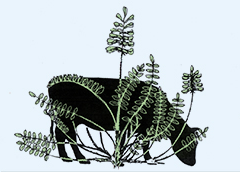Abstract
Larkspurs (Delphinium spp.) are toxic native plants on foothill and mountain rangelands in western North America, which poison cattle grazing on those rangelands. The purpose of this study was to examine in a laboratory setting, the subclinical effects of larkspur intake and toxicosis, by allowing larkspur susceptible and resistant cattle to self-select the amount of larkspur consumed in pellet form. We hypothesized that there would be differences in short term (9 – 11 day) pellet consumption between susceptible and resistant animals. Two trials were completed, each with larkspur resistant and susceptible Angus steers, and larkspur-alfalfa pellets at a 12% and 6% larkspur for trial 1 and trial 2, respectively. There were no differences in pellet consumption between the two groups in either trial. The cattle were averted to the 12% larkspur-containing pellet in trial 1. During trial 2, the susceptible and resistant steers differed in serum concentrations of methyllycaconitine (MLA) on days 9 to 12 but did not have significantly different exercise times (38.0 ± 3 min and 27.2 ± 6.5 min for resistant and susceptible steers, respectively). Larkspur alkaloids were potent aversive agents in cattle when fed as a 12% larkspur-containing pellet. The lack of differences in responses between susceptible and resistant cattle were attributed to the development of pharmacodynamic tolerance to larkspur alkaloids by the actions of larkspur alkaloids at nicotinic acetylcholine receptors.
Recommended Citation
Green, Benedict T.; Pfister, Jim; Gardner, Dale; Welch, Kevin; and Cook, Daniel
(2020)
"Dynamics of Larkspur (Delphinium barbeyi) Pellet Consumption and Tolerance of the Inhibitory Effects of Larkspur Alkaloids on Muscle Function in cattle.,"
Poisonous Plant Research (PPR): Vol. 3, p. 28-41.
DOI: https://doi.org/10.26077/zsrd-d783
Available at:
https://digitalcommons.usu.edu/poisonousplantresearch/vol3/iss1/3
Included in
Large or Food Animal and Equine Medicine Commons, Veterinary Toxicology and Pharmacology Commons

